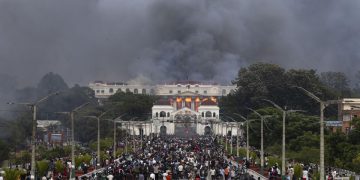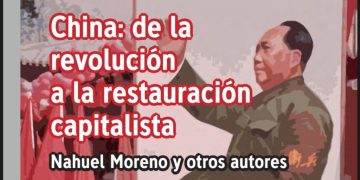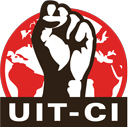There are those who foretell that China will be, in 20 or 25 years, the new world power, it might even surpass or replace the United States as a hegemonic power, trying to confirm the «success» of the return of capitalism in China.
Meanwhile, Fidel Castro, Hugo Chavez and sectors of the global reformist left have praised China, putting it as an example of «socialism of the XXI century» that would enable a «multipolar world» which would weaken, positively, the «unipolar world» imposed by U.S. imperialism.
Both are false. Neither is China an example of «social progress and success» under capitalism nor is a «modern» socialism that represents something positive for the people of the world.
China is a capitalist country that exploits millions
Against the claims of the Castro-Chavism, in China there is no socialism. It is a country where capitalism was restored under a bloody dictatorship of the Communist Party of China (CPC), in partnership with the world multinationals, which exploits millions of workers and peasants. In this way the Chinese masses lost the social gains they had since the triumph of the socialist revolution in 1949.
The social consequences of the restoration process are the rise in the levels of exploitation, falling income and of the levels of education and health care. In China it is estimated that there are 63 000 transnational corporations that produce for the world market on the basis of average wages of a miserly US$100-150 a month.
In 1978 began the process of restoration of capitalism under the leadership of Deng Xiaoping, who launched the slogan «To be rich is glorious». Since 1992, China has consolidated as a capitalist economy and country. That year, at the XIV Congress of the CPC it is resolved to build a «socialist market economy». Since then foreign investment and openness to capitalist norms grew abysmally. In 1997, the XV Congress is recognized as the «Congress of privatization». And in the XVI Congress of 2002, it was the apex of changing the statutes of the party to include «militant capitalists» as party members. In 2007 there is another decisive step towards consolidating the capitalist character of China. Then, the National Popular Assembly (APN), China’s parliament, approves a law that recognizes for the first time since 1949, the defence of private property. So it legalized the reversal of the greatest achievement of the socialist revolution led by Mao, the expropriation of the bourgeoisie and the landlords that transformed China into a deformed workers state, ruled by a Stalinist bureaucracy.
A giant factory
But the transformation of China as capitalist is very far from being able to become a great global hegemonic power nor is it an example of social progress.
Certainly China has had economic growth at an average annual growth of 10% over the past 20 years. For its overall production and for being the world’s largest exporter, it has managed to become, since 2011, the second largest economy, displacing Japan (US$ 5.3 trillion). But it is still far from the United States, which has a GDP of US$ 15 trillion to US$ 5.5 trillion of China. But the biggest difference is in the Per Capita GDP: the U.S., taking the figures for 2010, is first with US$ 46,360, while that of China is US$ 3,650 (in position 95), i.e., an abysmal difference. While, for example, Brazil Per Capita GDP was US$ 10,900 Brazil and Argentina’s US$ 8,775. Both countries exceed two or three times that of China. On the military side, the difference is also huge. Between 2000 and 2010, the United States invested in this sector nearly US$ 6 trillion. For its part, China spent 7.7 times less, a total of US$ 785 billion (data, notes of Daniel Mendez in ZaiChina website).
Chinese growth is not based on high technology development, but in a super-exploitation system unique in the world for its size, being the country with the largest population (1.33 billion), with miserable poverty wages and under a dictatorial regime. The essential basis relies on exports, mainly to the United States, of cheap products based on semi-slave labour.
The definition of China as a capitalist country has its peculiarities, on the basis that it is a country where capitalism was restored and is still governed by the CPC, a Stalinist party. It is not an imperialist country because it is a country that has been semi-colonized by the large multinationals of imperialist world (U.S. and European), which dominate it, and its total dependence on exports to those countries. China is a large semi-colony with respect to imperialism, such as, for example, Brazil, India and Russia, minding the differences. But in turn, it can be defined as a sub-imperialism or sub-metropolis; because it is a great capitalist country, like Brazil, which uses its corporations and its surplus capital to invest in other semi-colonies in its areas of influence or doing business with the imperialist metropolises themselves. It is no coincidence that China has 71% of its foreign investments in Asia and, in turn, is a major lender of money to the U.S. Even the capitalists rank China as part of the group called BIRC (Brazil, India, Russia and China), which have similar characteristics: they are semi-colonies and, in turn, sub-imperialist. The big capitalists shown them as «booming emerging countries» when, for example, «India and Brazil are still minor players with 2.2% and 2.7% of world production» … «The BIRC are not going to save the world» (Ha-Joon Chang, University of Cambridge, in Clarin, Argentina, 16/10/11).
In China social inequality grows
On the contrary, the reality is showing that in China, and in all countries of the so-called BIRC, what grows is social inequality, levels of overexploitation and the global capitalist crisis is approaching. In China, «the effects of the European crisis are also starting to show, with a fall of 18% in commercial traffic to Europe and a reduction, for the third consecutive year, of its trade surplus» (El País, 16/12/11). There are a drop in production and symptoms of financial problems and growing layoffs. In China, while the rich are getting richer, misery grows among the 800 million poor peasants. 45% of the urban population and 80% of the rural population have no form of health insurance and the «result is that life expectancy in rural western China is on average ten years less than in the cities of the East» (The Empire of Lies: The Truth About China in the Twenty-First Century, Guy Sorman, page 101). In addition to all this, China has one of the highest levels of environmental pollution. The sixth part of the rivers is polluted and acid rain affects more than half of the cities. In Beijing, pollution levels are chilling, to the point that the government had to ask 20 million Chinese to stay in their homes because of the smog. The future of China is not social progress of the masses either under a thriving capitalism or «market socialism, as defined by the CPC and the Castro-Chavism, but the growth of inequality, poverty and social decay.
A capitalist dictatorship
Few voices in the world rise up to denounce this sinister dictatorship of the Communist Party. The U.S. and European imperialism, who flap their mouths talking about «human rights», keep a complicit silence. They try to keep form with, every so often, some formal complaint. Meanwhile, they continue to invest and do business with their multinationals. Never a dictatorship assured them such exploitation and super-profits.
What happens in China with millions of exploited under semi-slavery labour can only be compared to what Hitler and Nazism dreamed for the world. And, additionally, this is done under the banner of an alleged socialism and supported by leaders like Fidel Castro, Chavez, Lula and other sectors of the world left. It is a Stalinist– bourgeois regime.
In China it is prohibited to form political parties outside the CPC. Any type of political, artistic or cultural dissent is persecuted. It gets to the extreme of trying to limit the use of the Internet. It is forbidden to freely form trade unions, peasants or student centres outside the official ones of the regime.
Revolutionary socialists consider that the central task of the Chinese workers, peasants and youth happens to be mobilizing to end this capitalist dictatorship of the CPC. We call for the widest international unity of action to all who agree with this goal. We are on the side of the workers and the Chinese people in their struggle for their demands for wages, for the right to strike, to freely form trade unions, peasant and student organizations, to democratically elect their labour leaders in companies and unions, for the freedom of political and union prisoners, for the free right of expression and Internet use; down with the one-party system, for the right to form and legalize political parties. All this, moving forward to achieving a true socialist government of workers, peasants and the people.
Waves of labour strikes and popular protests
What has been changing for several years in China is the growth of labour strikes across the country. Especially since the strike at Honda Nanhai in 2010, in the province of Guangdong, in southern China. This was the trigger for a wave of labour strikes that, with inequalities, has been maintained and encouraged other forms of protest. This was a 15-day strike for wage claim, which had the peculiarity that in it the workers demanded the right to elect leaders of their union. The strike succeeded, it was possible also to agree to conduct an election of the members of a trade union committee by secret ballot, although still under the control of the official union. The Honda strike would have quite an impact on the rest of the labour movement. The strikers released an «open letter» where they expressed that «Our struggle for rights is not intended to protect only the rights of 1,800 workers. We also care about the rights and interests of workers across the country.» (Article by Chloé Froissart in www.vientosur.info).
In 2010 there were 180,000 protests from strikes to protests for illegal expropriations, environmental claims or children killed by faulty construction of schools destroyed by the earthquake in Sichuan (data from El País, 23/12/11). In late 2011, thousands of workers went on strike in the south of the country. The wave of strikes occurred because in many companies in the province of Guangdong, due to the effects of the crisis layoffs increased and greater production was demanded. What is distinctive is that in many cases the government let the conflicts run and gave in to the demands. This has led in many industrial areas to a growth in salary. In January 2013, in Guangdong, there was an unprecedented strike of journalists of the Southern Weekly, from Guangzhou, capital of the province, against censorship by its director. The protesters carried placards with slogans such as «Freedom of expression is not a crime» and «The Chinese people want freedom» (El País, 8/01/13). Finally, the leadership of the CPC in Guangzhou gave in to the claim.
The dictatorship, worried about the progress of the protests and with fear of a popular «contagion» of the workers strikes and the democratic rebellion of the Arab peoples, is more cautious and even directs, for example, funds to the countryside to try to dampen protests in rural areas. These elements could indicate that there may be a shift in the national situation open after the defeat of the rebellion of Tiananmen Square in June 1989, where the counter-revolution was strengthened. If these trends are confirmed, it could move to a more favourable situation for the masses to confront the dictatorship. A future political destabilization in China would be a key change for the world revolutionary process.
Under capitalism, in China social inequality will continue to deepen, misery and exploitation of hundreds of millions of workers and peasants will increase. There is no prospect of lasting social improvement insofar as there is no revolutionary change to expel the multinationals and China’s new rich, and until the working class, youth and peasants are the ones who run the country and the economy, putting it at their service. Thus, one of the central tasks of revolutionaries in China is to build a revolutionary workers party to lead the struggle for a socialist revolution, to recapture the banners of the revolution of 1949, but without bureaucracy, without single party and with workers and people’s democracy.










































